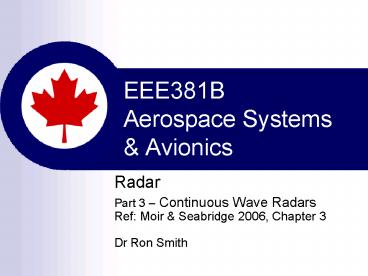EEE381B Aerospace Systems PowerPoint PPT Presentation
1 / 26
Title: EEE381B Aerospace Systems
1
EEE381BAerospace Systems Avionics
- Radar
- Part 3 Continuous Wave Radars
- Ref Moir Seabridge 2006, Chapter 3
- Dr Ron Smith
2
Outline
- Introduction
- Doppler radar
- Frequency-modulated CW radar
- Terrain-following radar (TFR)
- CW illumination
- Exercises
3
1. Introduction
- Pulsed radar is typically used to detect targets,
determining range and bearing. These radars
generally require high-power, are quite complex
and thus expensive. - Continuous wave (CW) radars typically determine
target velocity, and can achieve considerable
ranges without the high peak power. These radars
are typically simpler, more compact and less
costly.
4
2. Doppler radar 4
- Recall that the Doppler effect is the change in
frequency that occurs when a source and a target
are in relative motion. - The Doppler affect can be used in a CW radar in
order to determine velocity.
5
2.1.1 Doppler radar theory4
- Depicted below is a Doppler radar with transmit
wavelength ?t and period Tt. As a closing target
approaches at velocity v, the radar will observe
a shift in return wavelength, ?r as a function of
v. - ?r ?t 2vTt
6
2.1.1 Doppler radar theory5
- Depicted below is a Doppler radar with transmit
wavelength ?t and period Tt. As a closing target
approaches at velocity v, the radar will observe
a shift in return wavelength, ?r as a function of
v. - ?r ?t 2vTt
7
2.1.2 Why 2vTt ? 4
8
2.1.3 Doppler radar line of sight 4
9
2.1.4 Doppler radar velocity 4
- Substituting frequency for wavelength and
considering direction of target to line of sight,
yields a general expression for Doppler velocity. - v c(1- ft / fr ) / (2 cos(? ))
10
2.2 Doppler navigator radar
lamda configuration
11
3. FM-CW radar
- An unmodulated CW radar is incapable of detecting
range, as there is no reference point in the
transmitted or returned signal for measuring
elapsed time. - By frequency modulating the CW signal,
differences between the transmitted and received
frequencies can be used to estimate range. - The further the target, the larger the frequency
difference.
12
3.1.1 FM-CW radar theory 4
- The modulation parameters are frequency
deviation, ?f, and modulation period, Tm .
13
3.1.2 FM-CW radar theory 4
14
3.1.3 FM-CW radar theory 4
- closing target
15
3.1.4 FM-CW radar theory 4
- Given an FM-CW radar with triangular frequency
modulation of fm and frequency deviation ?f, the
range of a stationary target can be derived as
follows - fb tr dft/dt, where the round-trip transit
time, tr 2R/c, - and the changing transmit frequency, dft/dt
4fm?f. - Therefore
- fb (8Rfm?f/c), or R cfb/(8fm?f)
16
3.1.5 FM-CW radar theory 4
- Recall that the range resolution of a radar is a
measure of its ability to distinguish closely
spaced targets. The range resolution of a FM-CW
radar is a function of its modulating bandwidth,
and is c/(4?f). - The range ambiguity is the range beyond which the
radar yields ambiguous range results. The range
ambiguity of a FM-CW radar is a function of its
modulating frequency, and is cTm. - This is usually well beyond the signal range.
17
3.2 FM-CW radar architecture 4
18
4. CW Radar applications 1
- Radar altimeter
- Section 3.7.1 and Section 8.6.11
- Terrain-following radar
- Section 3.7.2
- CW illumination
- Section 3.7.2
19
4.1 Radar altimeter
- Triangular FM-CW radar is commonly used in
aircraft to determine the instantaneous altitude
above the terrain it is flying.
20
4.2 Terrain-following radar 1
21
4.3 CW illumination 1
- Used in conjunction with semi-active missiles.
The aircraft radar illuminates the target,
while the missile uses the received return signal
to track the target. - What are the advantages and disadvantages?
22
5. In-class exercises
23
5.1 Quick response exercise 1
- Recalling the radar range equation, why is it
possible for a CW radar to achieve much greater
ranges than a pulsed radar? - Can you think of an application in sports where a
simple Doppler radar may be employed?
24
5.2 Doppler calculation
- Just after take-off you realize that you are
following a military CC-138 (Twin Otter) in a
Cessna 152. Your air speed is 190 km/hour. You
estimate the that the Twin Otter is at an
approximate 15? angle above you. - You have a home-made 10.6 GHz Doppler radar
installed on the Cessna oriented straight ahead. - If the beat frequency on your Doppler radar is
1517 Hz, what is speed of the Twin Otter? - What range resolution can you get with this crude
radar?
25
5.3 Radar altimeter calculation
- An aircraft is equipped with an FM-CW radar
altimeter with a modulation frequency of 1.0 kHz
and a frequency deviation of 0.60 MHz. - Compute the beat frequency as a function of
range. - If the system has a measured beat frequency of 60
kHz, what is the aircraft altitude? - What is the range resolution of the altimeter?
- What frequency variation in MHz is required to
give a range resolution of 10m?
26
References
- Moir Seabridge, Military Avionics Systems,
American Institute of Aeronautics Astronautics,
2006. Sections 2.6 2.7 - David Adamy, EW101 - A First Course in Electronic
Warfare, Artech House, 2000. Chapters 3,4 6 - George W. Stimson, Introduction to Airborne
Radar, Second Edition, SciTch Publishing, 1998. - Principles of Radar Systems, student laboratory
manual, 38542-00, Lab-Volt (Quebec) Ltd, 2006. - Georgia State University, hyperphsyics,,
http//hyperphysics.phy-astr.gsu.edu/Hbase/sound/r
adar.html - Mark A. Hicks, "Clip art licensed from the Clip
Art Gallery on DiscoverySchool.com"

